Related Research Articles
Palaic is an extinct Indo-European language, attested in cuneiform tablets in Bronze Age Hattusa, the capital of the Hittites. Palaic, which was apparently spoken mainly in northern Anatolia, is generally considered to be one of four primary sub-divisions of the Anatolian languages, alongside Hittite, Luwic and Lydian.
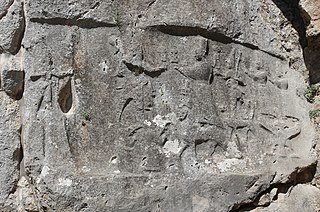
Teshub was the Hurrian weather god, as well as the head of the Hurrian pantheon. The etymology of his name is uncertain, though it is agreed it can be classified as linguistically Hurrian. Both phonetic and logographic writings are attested. As a deity associated with the weather, Teshub could be portrayed both as destructive and protective. Individual weather phenomena, including winds, lightning, thunder and rain, could be described as his weapons. He was also believed to enable the growth of vegetation and create rivers and springs. His high position in Hurrian religion reflected the widespread importance of weather gods in northern Mesopotamia and nearby areas, where in contrast with the south agriculture relied primarily on rainfall rather than irrigation. It was believed that his authority extended to both mortal and other gods, both on earth and in heaven. However, the sea and the underworld were not under his control. Depictions of Teshub are rare, though it is agreed he was typically portrayed as an armed, bearded figure, sometimes holding a bundle of lightning. One such example is known from Yazılıkaya. In some cases, he was depicted driving in a chariot drawn by two sacred bulls.
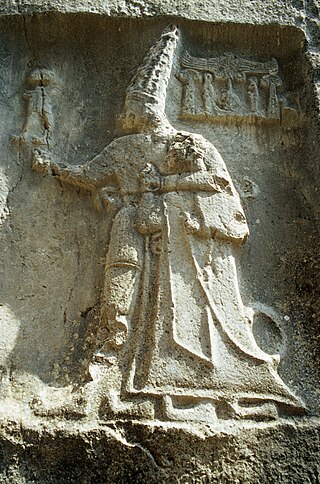
Šarruma, also romanized as Šarrumma or Sharruma, was a Hurrian god. He could be depicted in both anthropomorphic form, sometimes riding on the back of a leopard, and in the theriomorphic form as a bull. His character is not fully understood, though it is known that he could function as a mountain god. He was regarded as a son of Ḫepat and Teshub. He was also linked to various moon deities. Additionally, the only mythological text he appears in addresses him as a messenger (sukkalu) of Kumarbi. He was worshiped by Hurrians in southeastern Anatolia and northern Syria, for example in Kummanni and Lawazantiya in Kizzuwatna. From this kingdom he was introduced to the Hittite pantheon as well. Hittite influence in turn resulted in his introduction to cities such as Aleppo, Emar and Ugarit. He was also venerated in Luwian religion in the first millennium BCE, with theophoric names invoking him attested from as late as the Hellenistic period in Cilicia and Lycia.

Ḫepat was a goddess associated with Aleppo, originally worshiped in the north of modern Syria in the third millennium BCE. Her name is often presumed to be either a feminine nisba referring to her connection to this city, or alternatively a derivative of the root ḫbb, "to love". Her best attested role is that of the spouse of various weather gods. She was already associated with Adad in Ebla and Aleppo in the third millennium BCE, and in later times they are attested as a couple in cities such as Alalakh and Emar. In Hurrian religion she instead came to be linked with Teshub, which in the first millennium BCE led to the development of a tradition in which she was the spouse of his Luwian counterpart Tarḫunz. Associations between her and numerous other deities are described in Hurrian ritual texts, where she heads her own kaluti, a type of offering lists dedicated to the circle of a specific deity. She commonly appears in them alongside her children, Šarruma, Allanzu and Kunzišalli. Her divine attendant was the goddess Takitu. In Hittite sources, she could sometimes be recognized as the counterpart of the Sun goddess of Arinna, though their respective roles were distinct and most likely this theological conception only had limited recognition. In Ugarit the local goddess Pidray could be considered analogous to her instead.
Ḫašamili was a god worshiped in Bronze Age Anatolia. He originated in religious beliefs of the Hattians, and later came to be incorporated into the Hittite, Palaic and Luwian pantheons. He was regarded as a protective household deity, and was additionally associated with metalworking. He appears in the myth of Ḫaḫḫima, but his role in it is not fully understood.
Kamrušepa was a Hittite and Luwian goddess of medicine and magic, analogous to Hattic and Palaic goddess Kataḫzipuri. She is best known as one of the deities involved in the Telepinu Myth, in which her actions were crucial to pacify the anger of the "missing" vegetation god.
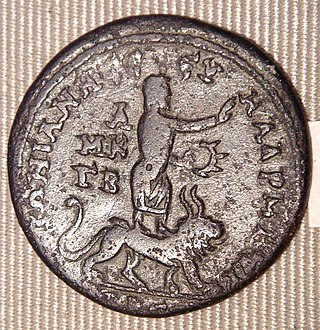
Šanta (Santa) was a god worshiped in Bronze Age Anatolia by Luwians and Hittites. It is presumed that he was regarded as a warlike deity, and that he could additionally be associated with plagues and possibly with the underworld, though the latter proposal is not universally accepted. In known texts he frequently appears alongside Iyarri, a deity of similar character. He is first attested in documents from Kanesh dated to the Old Assyrian period, and continues to appear in later treaties, ritual texts and theophoric names. He is also present in an offering lists from Emar written in Akkadian, though he did not belong to the local pantheon and rituals involving him were only performed on behalf of the Hittite administration by local inhabitants.
Ḫapantali, also known as Ḫapantaliya, was a Luwian goddess who functioned as a divine shepherd. She was also incorporated into Hattian and Hittite beliefs. She is first attested in the Old Assyrian period, and later continued to be worshiped until the fall of the Hittite Empire. She appears in a variety of texts, including descriptions of festivals, treaties, and myths. While in ritual texts she was often linked with Inar, in mythological context she instead could be designated as a helper of Kamrušepa or her husband Tiwad.

Tiwaz was the Luwian Sun-god. He was among the most important gods of the Luwians.

Tarḫunna or Tarḫuna/i was the Hittite weather god. He was also referred to as the "Weather god of Heaven" or the "Lord of the Land of Hatti".
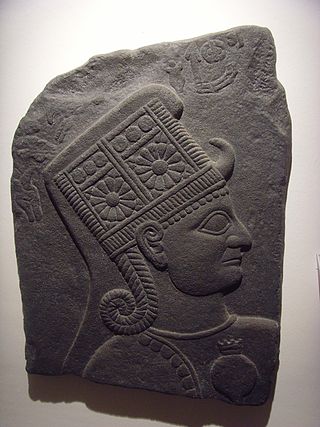
Kubaba was a goddess of uncertain origin worshiped in ancient Syria. Despite the similarity of her name to these of legendary queen Kubaba of Kish and Phrygian Cybele, she is considered a distinct figure from them both. Her character is poorly known. Multiple local traditions associating her with other deities existed, and they cannot necessarily be harmonized with each other. She is first documented in texts from Kanesh and Alalakh, though her main cult center was Carchemish. She was among the deities worshiped in northern Syria who were incorporated into Hurrian religion, and in Hurrian context she occurs in some of the Ugaritic texts. She was also incorporated into Hittite religion through Hurrian intermediaties. In the first millennium BCE she was worshiped by Luwians, Arameans and Lydians, and references to her can be found in a number of Greek texts.
Anna was the main deity of Kanesh, an Anatolian city which in the Old Assyrian period served as an Assyrian trading colony. Multiple possibilities regarding her origin have been considered by researchers. A temple, festivals and clergy dedicated to her are attested in texts from her city, and in contracts she appears alongside the Assyrian god Ashur. At some point her position declined, and an unidentified weather god became the main local deity instead. It is nonetheless assumed that she continued to be worshiped later on by Hittites and Luwians. It has also been proposed that a deity from Emar can be identified with her, though not all researchers share this view.
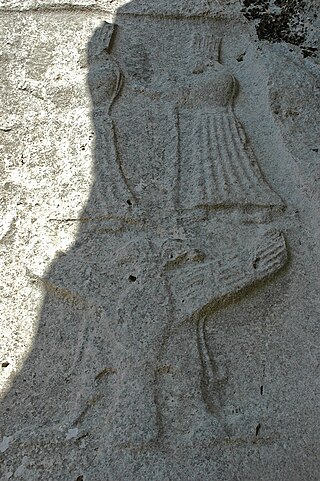
Allanzu, later known under the name Alasuwa, was a Hurrian goddess regarded as a daughter of Ḫepat. She was described as a youthful deity and in known texts often appears in association with her mother and siblings. She was also worshiped by Hittites and Luwians.
Ziparwa, originally known as Zaparwa, was the head of the pantheon of the Palaians, inhabitants of a region of northern Anatolia known as Pala in the Bronze Age. It is often assumed that he was a weather god in origin, though he was also associated with vegetation. Information about the worship of Ziparwa comes exclusively from Hittite texts, though some of them indicate that formulas in Palaic were used during festivals dedicated to him held in Hittite cities such as Hattusa.
Taru was a weather god worshiped in ancient Anatolia by Hattians. He was associated with the bull, and could be depicted in the form of this animal. It is presumed that the names of the Hittite and Luwian weather gods, Tarḫunna and Tarḫunz, while etymologically Indo-European, were meant to resemble Taru's as a result of Hattian cultural influence on other cultures of the region.
Šulinkatte was a Hittite god of Hattian origin. He was regarded as a war deity. Additionally, he could fulfill the role of a protector of palaces and houses. In the local tradition of Nerik, he was regarded as the father of the weather god of Nerik. He first appears in texts dated to the fifteenth or fourteenth century BCE. His main cult center was the sparsely attested city Tamarmara, but he was also worshiped elsewhere in ancient Anatolia, for example in Hattusa and Nerik. Fragments of a Hattic song celebrating him are also known.
Iyaya was a Hittite and Luwian goddess. Her functions remain uncertain, though it has been suggested she was associated with water or more broadly with nature. She might have been associated with the god Šanta, though the available evidence is limited. Her main cult centers were Lapana and Tiura, though she was also worshiped in other cities.
Ammamma was the name of multiple Hattian and Hittite goddesses worshiped in central and northern Anatolia in the Bronze Age. The best attested Ammamma served as the tutelary goddess of Taḫurpa near Hattusa, and appears in multiple treaties between Hittite kings and foreign rulers.
Kataḫzipuri was a goddess worshiped by Hattians, Hittites and Palaians in Bronze Age Anatolia. She was associated with magic, and was commonly invoked in rituals dealing with healing and purification. She was closely associated with Kamrušepa. In Palaic religion she formed a pair with Ziparwa and headed the pantheon alongside him.
Kammamma was a Hattian god worshiped by Hittites and Palaians. He belonged to the category of tutelary deities (DLAMMA) and might have been associated with vegetation. He attained a degree of importance in the Hittite state pantheon in the Old Hittite period, and in some cases he is listed in hierarchically arranged lists directly after Tarḫunna and the sun goddess of Arinna, the main Hittite deities.
References
- 1 2 3 4 5 6 7 Hutter 2014, p. 32.
- 1 2 3 Rutherford 2020, p. 165.
- 1 2 3 4 Taracha 2009, p. 58.
- ↑ Haas 2015, p. 612.
- ↑ Beckman 2011, p. 611.
- ↑ Taracha 2009, p. 59.
- ↑ Beckman 2011, p. 612.
- ↑ Taracha 2009, p. 52.
- ↑ Taracha 2009, p. 37.
- ↑ Yakubovich 2005, p. 108.
- ↑ Haas 2015, pp. 611–612.
- ↑ Taracha 2009, p. 116.
- ↑ Taracha 2009, p. 108.
- 1 2 Taracha 2009, p. 88.
- ↑ Yakubovich 2005, pp. 107–108.
- ↑ Yakubovich 2005, p. 109.
- ↑ Yakubovich 2005, p. 111.
- ↑ Yakubovich 2005, p. 121.
- ↑ Yakubovich 2005, p. 107.
Bibliography
- Beckman, Gary (2011), "Sonnengott A. II. In Anatolien. Philologisch · Sun god A. II. In Anatolia. Philological", Reallexikon der Assyriologie, retrieved 2022-12-08
- Haas, Volkert (2015) [1994]. Geschichte der hethitischen Religion. Handbook of Oriental Studies. Section 1: The Near and Middle East (in German). Brill. ISBN 978-90-04-29394-6 . Retrieved 2022-12-08.
- Hutter, Manfred (2014), "Tijat/z", Reallexikon der Assyriologie (in German), retrieved 2022-12-08
- Rutherford, Ian (2020). Hittite Texts and Greek Religion. Oxford University Press. doi:10.1093/oso/9780199593279.001.0001. ISBN 978-0-19-959327-9.
- Taracha, Piotr (2009). Religions of Second Millennium Anatolia. Dresdner Beiträge zur Hethitologie. Vol. 27. Wiesbaden: Harrassowitz Verlag. ISBN 978-3447058858.
- Yakubovich, Ilya (2005). "Were Hittite Kings Divinely Anointed? A Palaic Invocation to the Sun-God and Its Significance for Hittite Religion". Journal of Ancient Near Eastern Religions. Brill. 5 (1): 107–137. doi:10.1163/156921205776137972. ISSN 1569-2116.